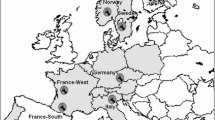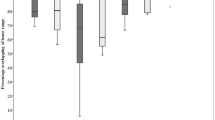Abstract
Male spacing behaviour of roe deer Capreolus capreolus (Linnaeus, 1758) was studied in a wooded mountainous habitat in the Casentinesi Forest National Park, Italy. Data were collected using radio-tracking techniques from March 1997 to February 1998. Annual, seasonal, and bimonthly home ranges were analysed. Different factors may influence male spacing behaviour throughout the year. Winter home range sizes may be dependent on environmental conditions, while social factors could determine a high level of individual variability during the territorial and reproductive period. Prime age males showed great spatial stability, in contrast to the ranging movements of yearlings.
Similar content being viewed by others
References
Bideau E., Vincent J. P., Quéré J. P. and Angibault J. M. 1983. Occupation de l’espace chez le chevreuil (Capreolus capreolus L., 1789). Cas des males. Acta Oecologica, Oecologia Applicata 4: 163–184.
Cederlund G. 1983. Home range dynamics and habitat selection by roe deer in a boreal area in central Sweden. Acta Theriologica 28: 443–460.
Chapman N. G., Claydon K., Claydon M., Forde P. and Harris S. 1993. Sympatric populations of muntjac (Muntiacus reevesi) and roe deer (Capreolus capreolus): a comparative analysis of their ranging behaviour, social organization and activity. Journal of Zoology, London 229: 623–640.
Danilkin A. 1996. Behavioural ecology of Siberian and European roe deer. Chapman & Hall, London: 1–227.
Fruziński B., Łabudzki L. and Wlazełko M. 1983. Habitat, density and spatial structure of the forest roe deer population. Acta Theriologica 28: 243–258.
Harestad A. S. and Bunnell F. L. 1979. Home range and body weight, a revaluation. Ecology 60: 389–402.
Harris S., Cresswell W. J., Forde P., Trewhella W. J., Woolard T. and Wray S. 1990. Home range analysis using radio-tracking data, a review of problems and techniques particularly as applied to the study of mammals. Mammal Review 20: 97–123.
Heezen K. L. and Tester J. R. 1967. Evaluation of radio-tracking by triangulation with special reference to deer movements. The Journal of Wildlife Management 31: 124–141.
Hewison A. J., Vincent J. P. and Reby D. 1998. Social organisation of European roe deer. [In: The European roe deer: the biology of success. R. Andersen, P. Duncan and J. D. C. Linnell, eds]. Scandinavian University Press, Oslo: 189–219.
Hewison A. J., Vincent J. P., Angibault J. M., Delorme D., Van Laere G. and Gaillard J. M. 1999. Test of estimation of age from tooth wear on roe deer of known age: variation within and among populations. Canadian Journal of Zoology 77: 58–67.
Janeau G., Quéré J. P., Spitz F. and Vincent J. P. 1981. Etude par radiotracking des variations saisonničres de l’étendue du domaine vital de cinq chevreuils (Capreolus capreolus L.). Biology of Behaviour 6: 291–304.
Johansson A. 1996. Territory establishment and antler cycle in male roe deer. Ethology 102: 549–5599.
Johansson A. and Liberg O. 1996. Functional aspects of marking behaviour by male roe deer (Capreolus capreolus). Journal of Mammalogy 77: 558–567.
Kenward R. 1987. Wildlife radio tagging. Academic Press, London: 1–222.
Kenward R. and Hodder K. H. 1996. Ranges V. An analysis system for biological location data. Centre for Ecology and Hydrology, Wareham Dorset, UK: 1–69.
Lamberti P., Rossi I., Mauri L. and Apollonio M. 2001. Alternative use of space strategies of female roe deer (Capreolus capreolus) in a mountainous habitat. Italian Journal of Zoology 68: 69–73.
Liberg O., Johansson A., Andersen R. and Linnel J. D. C. 1998. The function of male territoriality. [In: The European roe deer: the biology of success. R. Andersen, P. Duncan and J. D. C. Linnell, eds]. Scandinavian University Press, Oslo: 221–256.
Linnell J. D. C., Duncan P. and Andersen R. 1998. The European roe deer: a portrait of a successful species. [In: The European roe deer: the biology of success. R. Andersen, P. Duncan and J. D. C. Linnell, eds]. Scandinavian University Press, Oslo: 11–22.
McNab B. 1963. Bioenergetics and the determination of home range size. The American Naturalist 97: 133–140.
Mohr C. O. 1947. Table of equivalent populations of North America small mammals. American Midland Naturalist 37: 223–249.
Mysterud A. 1999. Seasonal migration pattern and home range of roe deer (Capreolus capreolus) in an altitudinal gradient in Southern Norway. Journal of Zoology, London 247: 479–486.
Rossi I., Lamberti P., Mauri L. and Apollonio M. 2001. Male and female spatial behaviour of roe deer in a mountainous habitat during pre-rutting and rutting period. Ibex, Journal of Mountain Ecology 6: 1–6.
San José C. and Lovari S. 1998. Ranging movements of female roe deer: Do home-loving does roam to mate? Ethology 104: 721–728.
Sempéré 1979. Utilisation et évolution du domain vital chez le chevreuil mâle européen déterminées par radiotracking. Biology of Behaviour 1: 75–87.
Strandgaard H. 1972. The roe deer population at Kala and the factors regulating its size. Danish Review of Game Biology 7: 1–205.
Thor G. 1990. How can does get more food than bucks? Habitat use of roe deer in the Bavarian Forest. Proceedings of the International Union of the Game Biologists Congress, Trondheim 19: 49–52.
Van Winkle W. 1975. Comparison of several probabilistic home range models. Journal of Wildlife Management 39: 118–123.
Vincent J. P., Bideau E., Hewison A. J. M. and Angibault J. M. 1995. The influence of increasing density on body weight, kid production, home range and winter grouping in roe deer (Capreolus capreolus). Journal of Zoology, London 236: 371–382.
Worton B. J. 1989. Kernel methods for estimating the utilization distribution in home range studies. Ecology 70: 164–168.
Author information
Authors and Affiliations
Corresponding author
Additional information
Associate Editor was Bogumiła Jêdrzejewska.
Rights and permissions
About this article
Cite this article
Rossi, I., Lamberti, P., Mauri, L. et al. Home range dynamics of male roe deerCapreolus capreolus in a mountainous habitat. Acta Theriol 48, 425–432 (2003). https://doi.org/10.1007/BF03194180
Received:
Accepted:
Issue Date:
DOI: https://doi.org/10.1007/BF03194180




